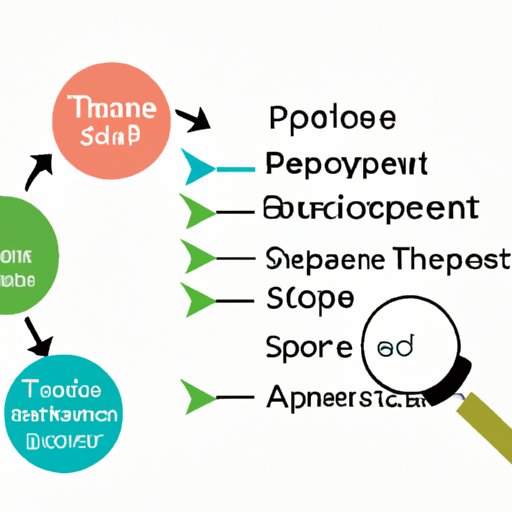
I. Introduction
Scope in project management refers to the boundaries and limits of a project in terms of its deliverables, timelines, budget, and resources. It involves the identification and documentation of all the work needed to achieve the project objectives and goals. Understanding scope is crucial to the success of any project since it determines the direction and parameters of the project. In this article, we explore the importance of scope in project management, its benefits, consequences, techniques for defining and managing scope, tips for developing a comprehensive project scope statement, and strategies for managing scope changes.
II. Understanding the Importance of Scope in Project Management
Having a clear project scope is beneficial in several ways:
- Provides a baseline for planning and decision making
- Helps ensure project objectives are met
- Makes it easier to monitor and control project progress
- Reduces the risk of misunderstandings and disagreements among stakeholders
- Improves communication and coordination among team members and stakeholders
On the other hand, confusion or lack of a clear project scope can lead to:
- Scope creep
- Time and cost overruns
- Low quality deliverables
- Unmet stakeholder expectations
- Disputes and conflicts among team members and stakeholders
III. The Role of Scope Creep in Project Failure
Scope creep refers to the gradual and uncontrolled expansion of project scope beyond the agreed-upon boundaries. It often results from a lack of clarity or understanding of the project objectives, insufficient stakeholder engagement, poor change management, or external factors beyond the project team’s control.
Scope creep can have severe consequences for project success, such as:
- Increased project duration and cost
- Reduced quality of deliverables
- Decreased stakeholder satisfaction
- Increased risk of project failure
To avoid scope creep, project teams should:
- Define and document the project scope clearly
- Engage stakeholders appropriately and regularly
- Establish a change management process
- Communicate changes effectively with stakeholders
- Control and monitor scope changes regularly
IV. Effective Techniques for Defining and Managing Project Scope
Defining project scope involves identifying and documenting the project objectives, deliverables, requirements, constraints, assumptions, risks, and dependencies. Some effective techniques for defining and managing project scope include:
- Work breakdown structure (WBS): a hierarchical and visual representation of the project work needed to achieve the objectives
- Mind mapping: a brainstorming technique that helps organize ideas and concepts related to the project
- Project charter: a document that officially authorizes the project and provides high-level information about the project scope, objectives, risks, and stakeholders
- Requirements traceability matrix (RTM): a tool that links project requirements to the project objectives and deliverables, helping track and manage changes to the project scope
Stakeholder engagement is also crucial in defining and managing project scope since stakeholders have a significant impact on the project and its outcomes. Engaging stakeholders effectively helps ensure their needs, expectations, and perspectives are taken into account when defining and managing project scope.
V. Getting Organized: Tips for Developing a Comprehensive Project Scope Statement
A project scope statement is a document that outlines the project objectives, deliverables, requirements, constraints, assumptions, risks, and dependencies in detail. Writing a comprehensive project scope statement involves:
- Identifying and documenting the project objectives, deliverables, and requirements
- Clarifying the project constraints, assumptions, risks, and dependencies
- Establishing acceptance criteria and performance measures
- Ensuring alignment with project objectives and goals
- Getting stakeholder approval and sign-off
The project scope statement serves as a reference point throughout the project and helps align team members and stakeholders around the project objectives and requirements.
VI. Why Communicating and Managing Scope Changes is Vital for Project Success
Scope changes are inevitable in any project due to various reasons such as changing requirements, emerging risks, or external factors beyond the project team’s control. Managing scope changes effectively is critical to achieving project success.
Some strategies for managing scope changes include:
- Establishing a change management process: a systematic and transparent process for requesting, assessing, approving, and implementing scope changes
- Communicating changes effectively: informing stakeholders in a timely and clear manner about the nature, impact, and rationale of scope changes
- Encouraging collaboration: involving stakeholders in the change management process and seeking their input and support in addressing scope changes
Effective scope change management helps maintain project momentum, control the project’s direction, and ensure stakeholder satisfaction.
VII. Conclusion
In conclusion, scope is a crucial aspect of project management that determines the direction and parameters of the project. Having a clear project scope is beneficial in several ways and reduces the risk of confusion or misunderstandings among stakeholders. However, scope creep can have severe consequences for project success, such as increased time and cost overruns and decreased stakeholder satisfaction. Effective techniques for defining and managing project scope include work breakdown structure, mind mapping, project charter, and requirements traceability matrix. Developing a comprehensive project scope statement involves identifying and documenting the project objectives, deliverables, requirements, constraints, assumptions, risks, and dependencies. Managing scope changes effectively requires establishing a change management process, communicating changes effectively, and encouraging collaboration among stakeholders.
Therefore, project teams and stakeholders should prioritize understanding and managing project scope to ensure the project’s success.




